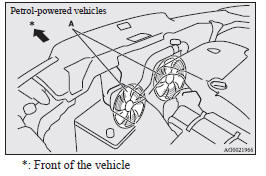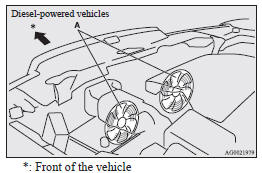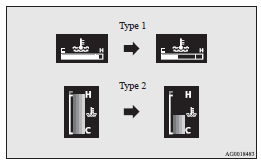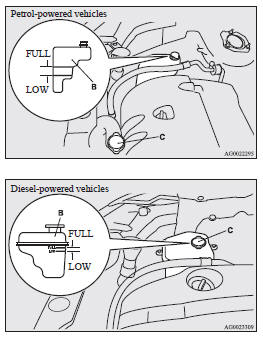Engine overheating
When the engine is overheating, the information screen in the multi-information
display will be interrupted and the engine coolant temperature warning display will
appear. Also  will blink.
will blink.
If this occurs, take the following corrective measures:
1. Stop the vehicle in a safe place.
2. Check whether steam is coming from the engine compartment.
[If steam does not come from the engine compartment] With the engine still running, raise the bonnet to ventilate the engine compartment.
![]() NOTE
NOTE
• For vehicles equipped with the Auto Stop &
Go (AS&G) system, press the “Auto Stop &
Go (AS&G) OFF” switch to deactivate the Auto Stop & Go (AS&G) system before stopping the vehicle.
Refer to “To deactivate”.
[If steam is coming from the engine compartment]
Stop the engine, and when the steam stops, raise the bonnet to ventilate the engine compartment.
Restart the engine.
![]() WARNING
WARNING
• Do not open the bonnet while steam is coming from the engine compartment. It could cause steam or hot water to spurt out, causing burns. Hot water could spurt out even when there is no steam coming out, and some parts will be very hot. Be very careful when opening the bonnet.
• Be careful of hot steam, which could cause the cap on the engine reserve tank to blow off.
• Do not attempt to remove the radiator cap (petrol-powered vehicles) or reserve tank cap (diesel-powered vehicles) while the engine is hot.
3. Confirm that the cooling fans (A) are turning.
If the fans are not turning, stop the engine immediately and have it checked.


![]() WARNING
WARNING
• Be careful not to get your hands or clothes caught in the cooling fan.
4. When the bar graph in the engine coolant temperature warning display in the multi-information display drops, stop the engine.

5. Check the coolant level in the reserve tank (B).

![]() WARNING
WARNING
• If there is none, make sure that the engine has cooled down before removing the radiator cap (C) (petrol-powered vehicles) or reserve tank cap (C) (diesel-powered vehicles), because hot steam or boiling water otherwise will gush from the filler port and may scald you.
6. Fill the reserve tank with coolant as needed.
(Refer to the “Maintenance” section.)
![]() CAUTION
CAUTION
• Do not add coolant while the engine is hot. Suddenly adding cold coolant could damage the engine. Wait for the engine to cool down, then add coolant a little at a time.
7. Examine the radiator hoses for coolant leakage and the drive belt for looseness or damage.
If there is anything wrong with the cooling system or drive belt, we recommend you to have it checked and repaired.
See also:
Obstacle detection areas
The detection areas of the corner and back sensors are limited to those shown
in the illustration. Moreover, the sensors are unable to detect low or thin objects
or objects near the rear bumper. T ...
Warning display list (when the ignition switch is “ON”)
...
Cargo net*
To use, attach the cargo net to the hooks as shown in the illustration. ...
